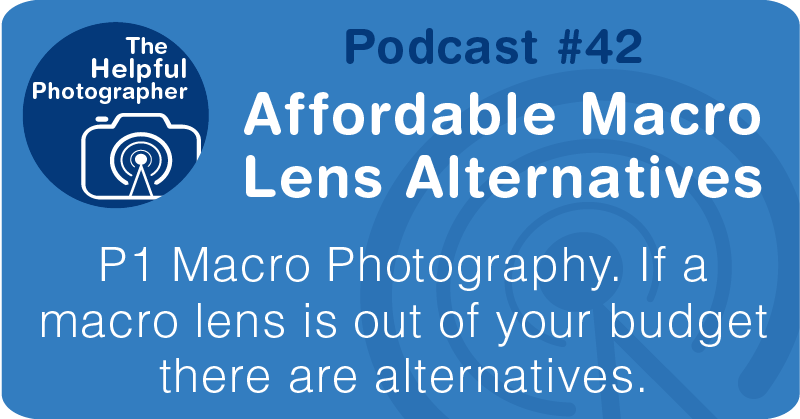Affordable Macro Lens Alternatives
Photo Tips Podcast: Affordable Macro Lens Alternatives #42

iTunes
Google
Spotify
Tune In
Stitcher
RSS
Pandora
Photo Tips Podcast: Affordable Macro Lens Alternatives #42
Spring has definitely arrived and here in the North East and flowers are already blooming and bursting with color, so it’s a great time to talk macro photography. This is the first of a three part series on macro photography and today I’m going to talk about lenses.
Unless you are shooting flowers that are more than about 3 inches big you’re probably going to need a macro lens. Although a lot of lenses out there have the word “macro” printed on them, most photographers would agree that they really aren’t. For the most part dedicated macro lenses are capable of a maximum reproduction ratio of one to one. The maximum reproduction ratio is also often termed as the maximum close-up magnification. Put simply this number dictates how much of the frame you’ll be able to fill with a small object. For a lens with a maximum reproduction ratio of 1:1 it would mean that you would be able to fill up your entire frame with an object that is the same size as your sensor and still retain focus. If you’re shooting a full frame sensor, you would be able to fill the frame top to bottom with a US quarter; yes I’m talking about a 25 cent coin, because a US quarter is 24.26 millimeters and full frame sensor is also 24mm. So if you can fill up the entire frame top to bottom with a US quarter then you have a one to one macro lens; also known as a 1x maximum reproduction ratio. If you can’t fill up your frame with a US quarter and hold focus you’re going to have a tough time shooting small objects.The fundamental problem with macro lenses is that they can be reasonably expensive and they are all fixed focal length lenses. Thus far I have yet to see a zoom lens that can achieve a 1:1 ratio, even though there are plenty of zoom lenses that are labeled macro. In those instances they are usually a 1 to 4 ratio or lower.
If budget is a problem and you don’t have hundreds to thousands of dollars to dedicate to a macro lens, there are three other inexpensive options you can take advantage of. A cheap option are close up filters – yup filters. These usually come in a set of 3 or 4 filters and range from $15 to $30 dollars a set. Just like any other filter, they sit on the front of your lens, but unlike other filters that change the color of the image, these basically act as a magnifying glass, oh and you can stack them too, so you can get even closer. The problem with close up filters is that they usually don’t have great glass so you won’t have the sharpest image, and they’re also pretty notorious for fall off, so the edges of your frame may have this out of focus look. Depending on how you handle your composition most people won’t notice those problems. The next option and the most expensive option of the cheaper alternatives, are extension tubes – note I said extension and not extender. Extender tubes are totally different. Unlike extender tubes, extension tubes don’t have glass. Like an extender they sit between your lens and your camera body. By moving your lens plane away from your sensor plane you will be able to get closer to your subject and still find focus. Extension tubes come in different sizes and can range from $20 to $100 dollars. The benefit of an close up filters and extension tubes is that you will still be able to use your auto focus and the other functions of your camera which means you’ll be able to shoot in auto or Aperture priority or whatever you want. The last option, which is potentially, the cheapest is to get a reverse mount adapter ring, for about $10. These rings fit on the front of the lens like a filter without glass, but what it allows you to do is it allows you to mount your lens backwards. What that means is that the front of your lens would be mounted to the body while the rear element would be facing forward. That’s why it’s called a reverse mount ring. Although you would be able to achieve a 1:1 reproduction depending on the lens that you are using, you are now using the lens well outside the parameters for which the lens was designed. Remember, the glass engineers that designed your lens designed it with the idea that the light would come through your lens in one particular direction and not the other direction. Another problem that you’ll find when you are reversing your lens is that you are going to lose autofocus altogether. You are going to lose access to your focus ring; the only way to focus on the object is to move your feet, so this makes it nearly impossible to be using a tripod unless you are capable of moving the subject or if you are shooting a subject that is completely static. So if you struggle shooting flowers outside using this method, well now you know why. Another aspect of your system that you are going to lose is access to your aperture ring. Unless you are shooting a really old lens with an actual aperture ring, you will need to go through several extra steps to move the aperture – which will require dismounting and remounting the lens a couple of times. The thing about all three of these options? Is that you are going to lose infinity focus. And that’s one of the reasons that you might want to get a real macro lens! Before you buy one of the cheaper options, you might take a look at sites like ebay or craigslist and see if you can find a used lens.
The last thing you should know about equipment for shooting macro is this. If you are shooting a DSLR or a mirrorless camera with interchangeable lenses, putting your camera into macro mode will not allow you to get any closer to your subject. You must have a macro lens or one of the cheap alternatives I just mentioned. So what good is the Macro mode? The purpose of macro mode is it’s going to move your settings around to attempt to give you a shallow depth of field and will likely give you punchier colors to.
In the next podcast I’ll talk about focus problems.











